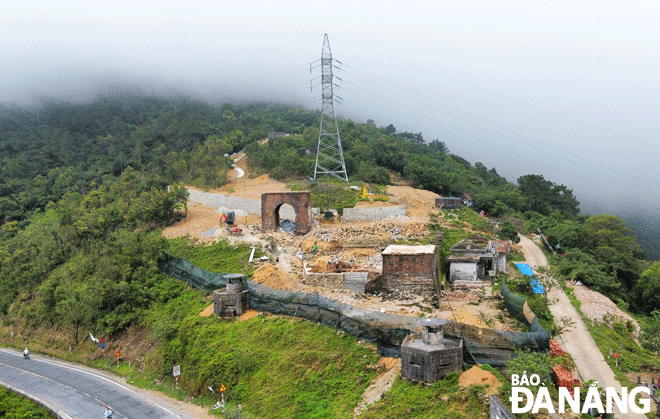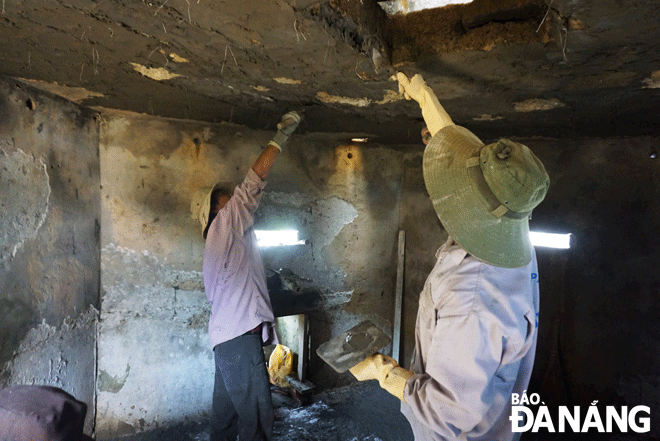Speeding up restoration of Hai Van Gate relic
After nearly 5 months of construction, many important items of the project of conservation, renovation, restoration and promotion of the value of Hai Van Gate national historical relic and architecture site have been completed, with the quality and aesthetics ensured. However, within the scope of this project, there are a number of problems related to the management by Da Nang and its neighbour Thua Thien Hue Province that are being removed to ensure the schedule progress.
 |
| The project of preserving, restoring and promoting the value of Hai Van Gate relic covers an area of about 6,500m2 with a total cost of VND42 billion (US$1.8 million) investment, using funds from Da Nang and Thua Thien - Hue Province. Photo: XUAN DUNG |
The Hai Van Gate-a complex of brick-built gates dating from the Tran Dynasty-sits at the top of its namesake mountain pass located at the geographical boundary between the city and Thua Thien-Hue Province.
The gate sits at the top of the Hai Van Pass which runs approximately 21 km across a spur of the larger Annamite Range that juts into the East Viet Nam Sea. Located at 490m above sea level, Hai Van Gate literally means ‘ocean cloud gate,’ referring to the mists that sometimes rise from the sea and reduce visibility.
The relic is on the border of Lang Co Town in Thua Thien-Hue Province’s Phu Loc District and Da Nang’s Hoa Hiep Bac Ward in Lien Chieu District.
It is situated on the Hai Van Pass, 28km away from Da Nang and 80km far from Hue, with access only for tankers or road adventurers travelling between the two localities since the Hai Van road tunnel became operational in 2005.
Ensuring project progress and quality
The project of preserving, restoring and promoting the value of Hai Van Gate relic covers an area of about 6,500m2 with a total cost of VND42 billion (US$1.8 million) investment, using funds from the two localities.
The project is being invested by the Hue Monuments Conservation Centre, with the Da Nang Department of Culture and Sports acting as a coordinator.
The preservation would focus on restoring ancient unique architecture and the design of old relics including the old citadel, the two gates and centuries-old north-south route on the top of Hai Van Pass between Hue and Da Nang.
Till date, the construction unit has dismantled the new blockhouse structures built with reinforced concrete and removed bricks that were tiled in 1945 - 1975.
Meanwhile, the renovation of 5 military bunkers built during the resistance wars has neared completion.
At the same time, the building of a retaining wall made of stone and a system of concrete walkways made of imitation concrete is underway with a workload of more than 30%.
Mr. Pham Hung Truong, Deputy Director of Central Institute of Construction Science and Technology, the project construction unit, said that despite the ravage of time and harsh climates, up to now, the basic structure of the two gates that were reinforced with concrete and steel-bar roofs in the country’s resistance wards are still very solid.
In particular, to ensure the safety of the construction process in the hilly terrain, the contractor is prioritising on completing a number of items such as the soil retaining wall system to proactively prevent the landslide process and the construction of the road surface between the two gates.
“The top of the Hai Van Pass witnesses’ complicated weather, so engineers and workers must arrange a reasonable working time, trying to complete important items before the rainy season.”, said Truong.
 |
| Workers are seen on duty the Hai Van Gate restoration project, ensuring the original elements of this relic site. Photo: XUAN DUNG |
People's Artist Huynh Van Hung, the former director of the Da Nang Department of Culture and Sports, said that the Hai Van Gate restoration project as well as solutions were appraised by the ministries of Culture, Sports and Tourism, Construction, and Natural resources and the Environment, so there is no signs of encroachment onto the monument.
The restoration and preservation of the Hai Van Gate complex is carried out on the principle of preserving the status quo, the original elements, including the bunkers built during the French colonial period and the resistance war against the US.
“Hai Van Quan is a historical work, falling into the memories of many generations of people. So, the implementation of this restoration project has been taken into careful consideration by the localities of Da Nang and Thua Thien Hue as well as experts. This is the first time that this monument has been restored and preserved on a large scale. Hopefully, upon completion, the project would stand the test of time and continue to become an attractive tourist venue,” said Mr. Hung.
Mutual coordination needed to solve problems
According to the Project Management Board - Hue Monuments Conservation Centre, the project currently is facing a number of problems under the management of many different units of the two localities that need to be removed soon in a bid to ensure construction progress.
Specifically, within the scope of the project, there is an abandoned post office managed by the People's Committee of Hoa Hiep Bac Ward, Lien Chieu District, Da Nang. Competent agencies have yet to find relevant documents to carry out the procedures to take down this facility.
Along with that, a 22kV power line running across the relic area is causing visual obstruction and blighting the landscape beauty.
Also, the scope of the project is related to the area of protection forest, requiring the completion of legal procedures for land conversion.
The Hue and Da Nang functional bodies are working together to handle the above-mentioned issues to pave the way for the restoration progress.
Reporting by XUAN DUNG – Translating by A.THU